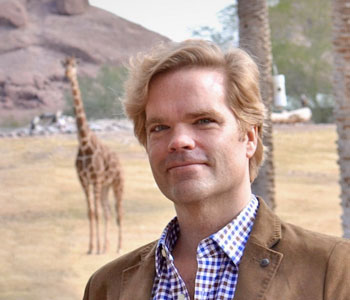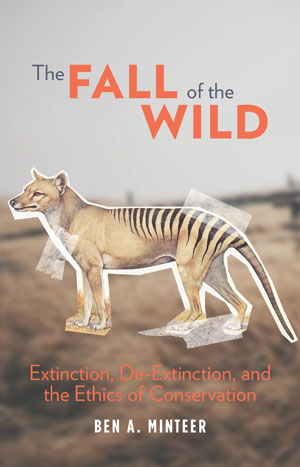
The Fall of the Wild is a book about the ethical challenges of conservation in a time of accelerating wildlife losses and growing scientific and technological power. In an age of extinction, biodiversity scientists and wildlife advocates have sought to curb species declines and extinctions via a range of scientific and policy strategies, from the traditional (regulations, referenda, and refuges) to the novel (the scientific wizardry of genetic engineering). The more ambitious and aggressive conservation approaches, however, raise thorny questions about the ethical consequences of our expanding incursions in wild populations and places.
Can we, for example, uphold our responsibilities to protect wild species while at the same time avoid taking too heavy a hand in these efforts? How do we balance our desire to “do whatever it takes” to save species headed toward extinction while still preserving a meaningful understanding of the wild as something we don’t design and control? In the book, I argue that the tension between these two impulses ripples through a wide range of conservation questions and challenges, from the field, to the zoo, to the lab.
Centered on a series of iconic episodes of species extinctions (from the great auk to the Tasmanian tiger), the book makes the case that some of our more heroic efforts to study, restore, and conserve species actually pose a threat to the ideal of preserving a wild nature that isn’t completely under the human thumb. From collecting wildlife specimens for museums and the wilderness aspirations of zoos, to the high-tech attempt to “revive” long-extinct species using cutting-edge biological and engineering techniques, the book explores the science and ethics of conservation in a time of increasing societal concern, scientific acumen, and ecological impact.
The Fall of the Wild should therefore be read as an accessible and informed overview of some of the moral dilemmas gripping our efforts to save wild species today, as well as a guide to long-running and emerging conservation practices and debates that have shaped the human-nature relationship in the modern era.
For a long time, the field of environmental ethics has been dominated by non-anthropocentrism, i.e., the belief that nature has intrinsic value and that we have powerful duties to promote the integrity of wild species and landscapes. Even though I support most of the policy goals of non-anthropocentrism, I’m uncomfortable with some of the philosophical and political implications. And so, for years I’ve defended an alternative outlook, a position known as “environmental pragmatism.” It’s an approach that recognizes the range of environmental values beyond intrinsic value, focuses on the practical consequences of ideas rather than their theoretical “truth,” and embraces an experimental process of moral judgment rather than the prescription of fixed moral principles.
Recently, though, I’ve found myself reassessing and calibrating my pragmatism as I’ve watched the rise of a more strongly anthropocentric and technophilic environmentalism, the boldest versions of which exude an almost Promethean view of unchecked human power in nature. Although these newer arguments often travel under the banner of “environmental pragmatism” or “eco-modernism,” to me they’re far too reckless – and too motivated by a desire to elevate us into the role of planetary masters – to count as a genuinely pragmatic environmental ethic. They certainly lack the sense of caution and contingency that defined the work of thinkers like William James and John Dewey, two pillars of the American pragmatist tradition.
In addition, then, to taking stock of the moral wages of our wildlife protection efforts, The Fall of the Wild is also about my coming to terms with the meaning and limits of my own pragmatism, both as an environmental ethicist and as a conservationist. Since the book is written for a general audience rather than for philosophers, I mostly keep this theme under wraps in the text. But it pops up in several places in the book, especially in the conclusion. There, I defend what I call “pragmatic preservationism,” an undeniably clunky term but one that captures what I see as the main ethical challenge coursing through the book: the need to balance human mediation of nature with a sense of the wild that isn’t designed and prodded within an inch of its life.
Although The Fall of the Wild is text-driven, it contains a number of photographs, some of them quite famous in the visual history of wildlife conservation.
Chapter three (“The Call of the Quasi-Wild”) is focused on zoos and their relationship to the wild. It opens with a discussion of the case of the American bison or buffalo, a species that was pushed to the edge of the cliff by hunters in the 19th century. The photograph on page 40 features a staggeringly huge mound of bison skulls stacked so high they dwarf the human figures in the scene, one of whom is standing on top of the pile proudly brandishing a skull, presumably for the photographer. The skulls were on their way to being ground up for fertilizer, but the moment captured in the picture is indelible. Tens of millions of animals would be slaughtered on the plains, a pace that accelerated when a commercial market in bison leather took hold in the last third of the 19th century.
Although many of the cases discussed in the book end with a species lost forever, the bison is an example of a species that was pulled out of the fire by the timely efforts of conservationists, including a pioneering breeding and reintroduction program at the Bronx Zoo. In fact, another photograph in the chapter is of a bison being prepared to ship to a preserve in Oklahoma, a picture that signals not just a shift in the animal’s fate but a remarkable transformation in conservation ethics over only a few decades.
Another powerful image appears later in the book in the chapter “Promethean Dreams.” In the left side of the frame is a dead Tasmanian tiger (aka thylacine), a large, carnivorous marsupial with a distinctive striped back. The animal is strung up by its hind quarters, facing the hunter who took the fatal shot, a man identified only as “Mr. Weaver.” The thylacine was persecuted by sheep farmers and bush hunters in Australia’s rugged island state in the 19th century, even though the failure of the Tasmanian sheep industry owed more to human incompetence than to these allegedly “bloodthirsty” marsupials. Unlike the bison, the thylacine’s story doesn’t have a happy ending. “Benjy,” the last of the species, died in a Tasmanian zoo in 1936.
The thylacine has emerged as one of the candidate species for “de-extinction,” an effort to use high-tech genetic methods to try to bring back lost species using remnant DNA from museum specimens. In The Fall of the Wild I argue strongly against this idea, suggesting that in celebrating and applying human technological control over nature, it represents not a moral reversal toward species we wantonly destroyed in the past, but rather a failure to learn the lessons that drove species like the thylacine to extinction in the first place.
I hope The Fall of the Wild makes us think deeply about the moral consequences of our more aggressive efforts to save and restore biodiversity, especially during what appears to be a time of great upheaval in conservation. The caution and restraint characterizing an older preservationist approach to wildlife and wild places have explicitly been called into question by “new” conservationists more enamored of technology and development – and less concerned about safeguarding a wild nature beyond our grasp.
But I also want the book to reach a wider audience, especially readers who may be unfamiliar with some of the events and trends it discusses. Many people care about the future of wild things but simply haven’t had the time or the occasion to stop and think about some of the trade-offs and moral questions raised by our increasingly manipulative and interventionist attempts to conserve a biologically diverse future. The traditional threats to wild species – i.e., bulldozers and bullets, pollution and (over-)population – rightly attract the lion’s share of attention in our conservation efforts. But as the book demonstrates, our impressive conservation techniques and ambitions can also raise troubling concerns about our environmental ethics, especially if we forget that we are merely one species among many, albeit a very clever and uniquely powerful one.
So I hope The Fall of the Wild is successful in carrying this message forward, and that it might spark a larger discussion about what we think we are doing, and, more importantly, what we should be doing, in our dogged fight against extinction.


Ben A. Minteer, Ph.D., is professor of environmental ethics and conservation and the Arizona Zoological Society Endowed Chair in the School of Life Sciences at Arizona State University. His work has appeared in Science, Nature, PNAS, BioScience, Conservation Biology, Environmental Ethics, Slate, and Earth Island Journal, among other outlets. He has also published many books, including The Ark and Beyond: The Evolution of Zoo and Aquarium Conservation (University of Chicago Press) and The Landscape of Reform: Civic Pragmatism and Environmental Thought in America (MIT Press).